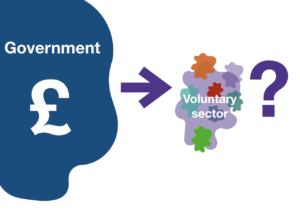How much does the UK government give in grants?
Grants from government are a crucial part of the voluntary sector’s funding mix. In this post, David Kane uses identifiers to explore the 2017/18 government grants data and understand the types of organisations which received funding.
Updated data Since this blog was released, 16 central UK Government departments have published open data about the grants they have made using the 360Giving Data Standard. Read our 2021 blog post about the grants published.
Grants from government are a crucial part of the voluntary sector’s funding mix – but surprisingly, it’s very difficult to find out how much these grants are worth or where they go.
NCVO’s 2019 UK Civil Society Almanac has a figure of £7.3bn for UK charities’ income from central government for 2016/17 (with a further £7.3bn from local government and £1.2bn from international governments).

The latest Almanac doesn’t break this into grants and contracts. But applying the ratio from previous Almanacs suggests around £2bn in grants from central government and £1bn from local government, giving a total of £3bn worth of government grants to the voluntary sector in 2016/17.
The Almanac uses a sample of data from grant recipients to reach these figures; but this shouldn’t be our only source on this. Surely we can find out how much the government says it has given in grants? Well, we’re getting closer. As part of the Open Government Partnership, the government has committed to publish data about the grants that it makes. But this data isn’t perfect either.
Government publishes data about the grants it has made in a single file each year – and at the moment this data isn’t in the 360Giving standard format. It also has some data quality issues. This makes it hard to understand and compare these grants alongside those made by other major funders, such as the lottery funds.
The latest government data is for 2017/18 and has grants with total amount awarded of £10.8bn. But this data includes all sorts of grants – block grants to local authorities, to NDPBs (non-departmental public bodies) and delivery organisations (like Network Rail) as well as grants for charities and private sector organisations. In order to see how much of this money goes to charities, we need to work out what types of organisations have received grants.
The easiest way to find the type of organisation is by using identifiers – for example if an organisation has a charity number we know its a registered charity. But for many of the recipients in the government grants data there is no identifier, so we have to guess the type of organisation from the registered name. We couldn’t work out the organisation type for 12% of the grant recipients.
We also worked out the grant amount going to each of these organisation types. We found that more than half of the amount awarded by the government is going to local authorities (around £5bn), followed by universities with £2bn. Charities get only 3.5% of all of the amount awarded from central government (£380m). There are also £1.5bn worth of grants to unclassified organisations, and we can assume that some of these are UK charities.
So we’ve got a figure of £2bn from the Almanac vs c£400m-800m from the government grants data.
We wouldn’t expect these figures to match – they’re based on different datasets, using different methods, definitions (both what counts as a grant and which organisations are included) and timeframes. But we think the grants data can be improved to help answer our initial question and dive deeper into government grant funding:
- The Government should publish all its grants data in the 360Giving standard so it can benefit from the ecosystem of tools and researchers that use the standard. The Government has committed to do this already, and the 360Giving standard has been chosen by the Open Standards Board as the approved way to publish this type of data, so we look forward to seeing this soon.
- The data should include appropriate organisational identifiers so we can understand the different types of organisations receiving funding, and easily link to other datasets to add context to the data. We’ve previously written about the value that organisation identifiers provide.
- The NCVO Almanac figures show that central government is only half the picture for government grantmaking. The Government should encourage local authorities to publish their grants data in the 360Giving format and give them the resources to do so. Currently, only a handful of local authorities publish this data on a timely basis. The Local Government Transparency Code requires local authorities to publish data on their grant spending – the 360Giving standard is an ideal way to achieve this.
We’ve published some more detailed tables on how we think the government grant data breaks down by type of organisation.
